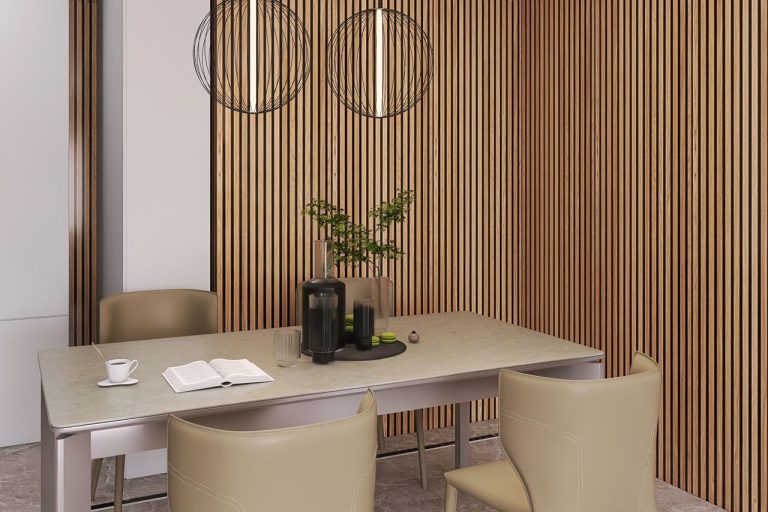
Unlocking the Mystery: The Difference Between Paneling and Wainscoting
Paneling and wainscoting have always added elegance, sophistication, and usefulness to interiors. However, they are often confused. Let’s compare their styles and help you pick the right one for your room. Whether you choose paneling or wainscoting, both enhance the
of your space.
The Basics: What Sets Paneling Apart
Paneling is an adaptable wall treatment that involves covering walls with wood or synthetic panels to add texture, insulation, or aesthetic appeal. It’s a popular choice for generating a warm or dramatic ambiance in any environment.
Popular Styles of Paneling
Here are some paneling styles to consider:
- Shiplap: Creates clean, horizontal lines perfect for a farmhouse or coastal vibe.
- Beadboard: Adds cottage-style charm with narrow, vertical planks separated by grooves.
- Tongue and Groove: Features interlocking panels for a seamless, timeless look.
- Board and Batten: Combines wide boards with thin strips (battens) for a rustic, yet modern, effect.
Benefits of Choosing Paneling
Paneling offers both beauty and practicality:
- Adds insulation to the rooms.
- Protects the walls from damage.
- Provides a durable and easy-to-clean surface.
- Enhances appearance with limitless design options.
A Closer Look at Wainscoting
Wainscoting, on the other hand, is a decorative feature that is typically applied to the lowest half of walls. It began as a protective measure but has grown into a complex design element. Wainscoting is perfect for creating a formal look in living and
.
Types of Wainscoting to Elevate Your Interiors
Different styles cater to various aesthetics:
- Raised Panel Wainscoting has panels that protrude slightly for an exquisite, timeless appearance.
- Flat Panel Wainscoting: Sleek and sleek, featuring recessed panels for a minimalist look.
- Overlay Wainscoting: Combines ornamental molding with flat panels to provide dimension.
- Beadboard Wainscoting: Similar to beadboard paneling, it adds a traditional yet informal touch.
Why Wainscoting Stands Out
Wainscoting enhances a space while serving practical purposes:
- Enhances architectural depth and sophistication.
- Protects walls from scuffs, especially in high-traffic areas.
- Suitable for a variety of design styles, including traditional and transitional.
Paneling vs. Wainscoting: Comparing Design, Purpose, and Style
Although paneling and wainscoting share similarities, their distinctions are clear:
| Feature | Paneling | Wainscoting |
|---|---|---|
| Coverage | Often spans the entire wall. | Limited to the lower portion of the wall. |
| Primary Purpose | Focuses on aesthetics, insulation, and texture. | Combines aesthetics with wall protection. |
| Style Variations | Offers a wide range of styles, from rustic to modern. | Typically leans toward traditional or classic designs. |
When to Choose Paneling or Wainscoting
Consider these factors to guide your decision:
Go with Paneling if:
- You want a fully textured or warm wall design.
- You’re seeking flexibility in modern or rustic themes.
Opt for Wainscoting if:
- You prefer a timeless, formal appeal.
- You want added wall protection in high-traffic areas like hallways or staircases.
Fresh Ideas for Your Walls
When deciding between paneling and wainscoting, explore creative applications for these wall treatments:
- Combine shiplap paneling with wainscoting for a sophisticated look.
- Use contrasting colors to emphasize the texture and depth of the wainscoting.
- For a more modern look, try vertical or diagonal paneling.
Frequently Asked Questions
1. What is the main difference between paneling and wainscoting?
The fundamental distinction is in their application: paneling usually covers complete walls, whereas wainscoting is limited to the lowest portion of a wall. Wainscoting is ideal for
in high-traffic areas like hallways.
2. Can I use paneling and wainscoting in the same room? Absolutely! Mixing these treatments can add visual intrigue and a layered feel to your room.
3. Is wainscoting outdated?
Not at all. While wainscoting has historical roots, new styles and materials make it a timeless option for contemporary interiors.
4. Which is more affordable: paneling or wainscoting?
The cost is determined by the materials used, the work required, and the area covered. Wainscoting is frequently less expensive since it covers a smaller surface area.
5. How do I maintain paneling and wainscoting?
Both are simple to maintain—regular dusting and the odd wiping with a moist cloth will keep them looking good.
Elevate Your Home with the Right Wall Treatment
Whether you like paneling for its strong texture or wainscoting for its subtle appeal, both are fantastic ways to improve your house. Understanding the difference between paneling and wainscoting allows you to choose a style that properly complements your design idea.